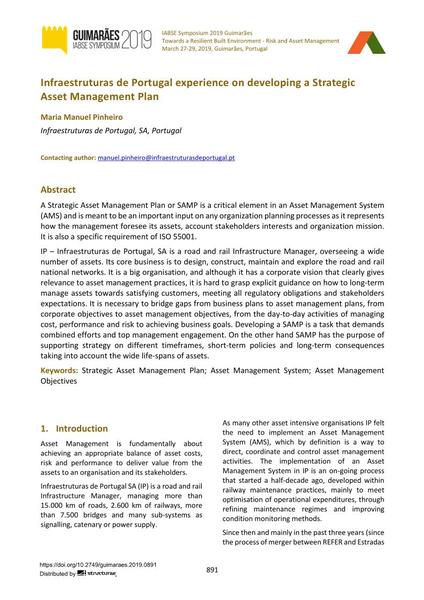Infraestruturas de Portugal experience on developing a Strategic Asset Management Plan

|
|
|||||||||||
Détails bibliographiques
| Auteur(s): |
Maria Manuel Pinheiro
(Infraestruturas de Portugal, SA, Portugal)
|
||||
|---|---|---|---|---|---|
| Médium: | papier de conférence | ||||
| Langue(s): | anglais | ||||
| Conférence: | IABSE Symposium: Towards a Resilient Built Environment Risk and Asset Management, Guimarães, Portugal, 27-29 March 2019 | ||||
| Publié dans: | IABSE Symposium Guimarães 2019 | ||||
|
|||||
| Page(s): | 891-899 | ||||
| Nombre total de pages (du PDF): | 9 | ||||
| DOI: | 10.2749/guimaraes.2019.0891 | ||||
| Abstrait: |
A Strategic Asset Management Plan or SAMP is a critical element in an Asset Management System (AMS) and is meant to be an important input on any organization planning processes as it represents how the management foresee its assets, account stakeholders interests and organization mission. It is also a specific requirement of ISO 55001. IP – Infraestruturas de Portugal, SA is a road and rail Infrastructure Manager, overseeing a wide number of assets. Its core business is to design, construct, maintain and explore the road and rail national networks. It is a big organisation, and although it has a corporate vision that clearly gives relevance to asset management practices, it is hard to grasp explicit guidance on how to long-term manage assets towards satisfying customers, meeting all regulatory obligations and stakeholders expectations. It is necessary to bridge gaps from business plans to asset management plans, from corporate objectives to asset management objectives, from the day-to-day activities of managing cost, performance and risk to achieving business goals. Developing a SAMP is a task that demands combined efforts and top management engagement. On the other hand SAMP has the purpose of supporting strategy on different timeframes, short-term policies and long-term consequences taking into account the wide life-spans of assets. |
||||
